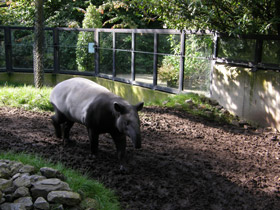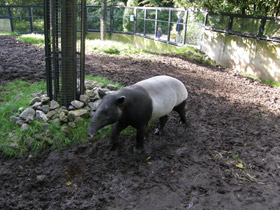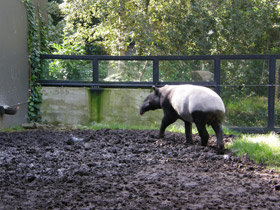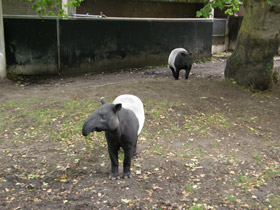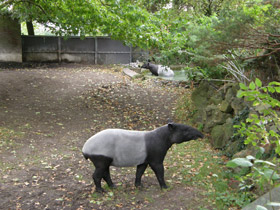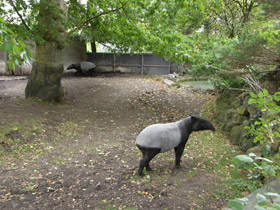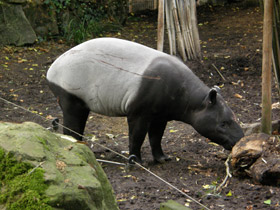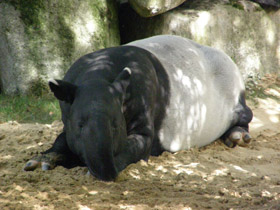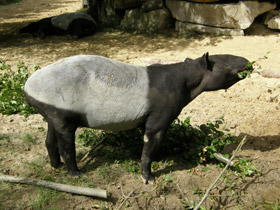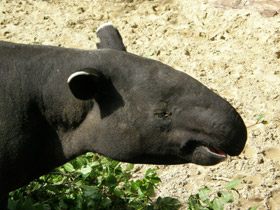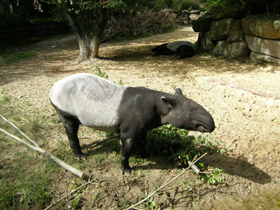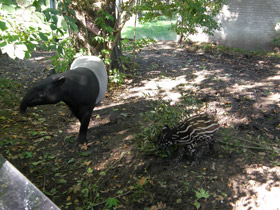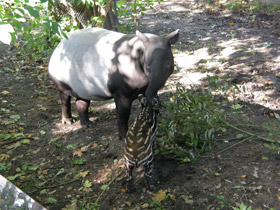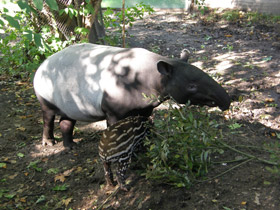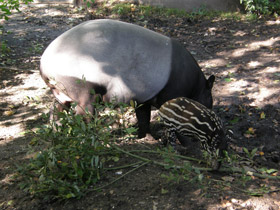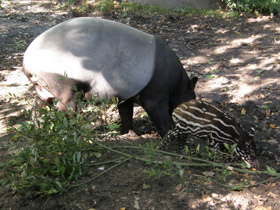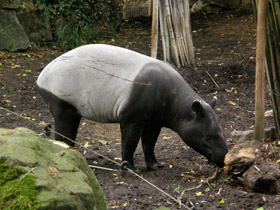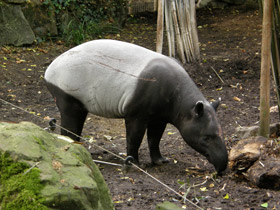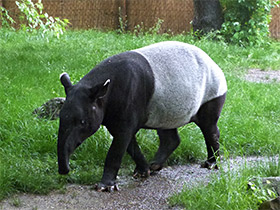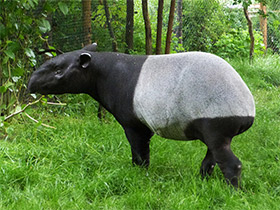The Malayan tapir (Tapirus indicus), Asian tapir, Asiatic tapir, oriental tapir, Indian tapir, piebald tapir, or black-and-white tapir
The Malayan tapir (Tapirus indicus), also called Asian tapir, Asiatic tapir, oriental tapir, Indian tapir, piebald tapir, or black-and-white tapir, is the only living Tapir species outside of the Americas. It is native to Southeast Asia from the Malay Peninsula to Sumatra. It has been listed as Endangered on the IUCN Red List since 2008, as the population is estimated to comprise fewer than 2,500 mature individuals.
Taxonomy
The scientific name Tapirus indicus was proposed by Anselme Gaëtan Desmarest in 1819 who referred to a Tapir described by Pierre-Médard Diard. Tapirus indicus brevetianus was coined by a Dutch zoologist in 1926 who described a black Malayan tapir from Sumatra that had been sent to Rotterdam Zoo in the early 1920s.
Phylogenetic analyses of 13 Malayan tapirs showed that the species is monophyletic. It was placed in the genus Acrocodia by Colin Groves and Peter Grubb in 2011. However, a comparison of mitochondrial DNA of 16 perissodactyl species revealed that the Malayan tapir forms a sister group together with the Tapirus species native to the Americas. It was the first Tapirus species that genetically diverged from the group, estimated about 25 million years ago in the Late Oligocene.
Appearance and nutrition
Tapirus indicus is a species of perissodactyl mammal of the tapir family.
Tapirus indicus is the only Asian tapir. It is the largest member of the family, with a body length of about 250 cm and a weight of about 300 kg. The tapir's trunk is long and strong, and its legs are powerful. The colour of this beast is very unusual: the front third of its body, neck, head and legs are black, while the central part of the body is greyish white, as if covered by tapir. Young Tapirus indicus are as striped as other tapirs and it is only at about 5 months of age that the remaining spots and stripes disappear and the cheprach is formed.
Tapirus indicus readily eats leaves and grasses from meadows (especially poplar and willow leaves), is very fond of maize (young cobs and leaves) and eats rice porridge and apples.
Colour variation
Two melanistic Malayan tapirs were observed in Jerangau Forest Reserve in Malaysia in 2000. A black Malayan tapir was also recorded in Tekai Tembeling Forest Reserve in Pahang state in 2016.
Distribution and habitat
The Malayan tapir is distributed throughout the tropical lowland rainforests of Southeast Asia, including Sumatra in Indonesia, Peninsular Malaysia, Myanmar, and Thailand. Populations in Sabah in Borneo may have persisted until recently but are now considered extinct. The Malayan tapir is a species of tapir.
Particularities
The contrasting dismembered colouration hides Tapirus indicus unusually well in the forest understory - on a sunny day recumbent Tapirus indicus is very difficult to see. Due to logging and forest development, their numbers are rapidly declining. However, it is common to see in Thai markets tapir meat called munam, similar to pork. Fortunately, Tapirus indicus live and breed well in some zoos. Tapirus indicus are known to live up to 30 years in captivity.
Behaviour and ecology
Malayan tapirs are primarily solitary, marking out large tracts of land as their territory, though these areas usually overlap with those of other individuals. Tapirs mark out their territories by spraying urine on plants, and they often follow distinct paths, which they have bulldozed through the undergrowth. Exclusively herbivorous, the animal forages for the tender shoots and leaves of more than 115 species of plants (around 30 are particularly preferred), moving slowly through the forest and pausing often to eat and note the scents left behind by other tapirs in the area. However, when threatened or frightened, the tapir can run quickly, despite its considerable bulk, and can also defend itself with its strong jaws and sharp teeth. Malayan tapirs communicate with high-pitched squeaks and whistles. They usually prefer to live near water and often bathe and swim, and they are also able to climb steep slopes. Tapirs are mainly active at night, though they are not exclusively nocturnal. They tend to eat soon after sunset or before sunrise, and they will often nap in the middle of the night. This behaviour characterizes them as crepuscular animals.
Lifecycle
The gestation period of the Malayan tapir is about 390–395 days, after which a single calf is born that weighs around 6.8 kg (15 lb). Malayan tapirs are the largest of the four tapir species at birth and in general grow more quickly than their relatives. Young tapirs of all species have brown hair with white stripes and spots, a pattern that enables them to hide effectively in the dappled light of the forest. This baby coat fades into adult coloration between four and seven months after birth. Weaning occurs between six and eight months of age, at which time the babies are nearly full-grown, and the animals reach sexual maturity around age three. Breeding typically occurs in April, May or June, and females generally produce one calf every two years. Malayan tapirs can live up to 30 years, both in the wild and in captivity.
Predators
Because of its size, the Malayan tapir has few natural predators, and even reports of killings by tigers (Panthera tigris), leopards (Panthera pardus), or dholes (Cuon alpinus) are scarce.
Threats
The main threat to the Malayan tapir is loss and destruction of habitat through deforestation. Large tracts of forests in Thailand and Malaysia have been converted for planting oil palms. Habitat fragmentation in peninsular Malaysia caused displacement of 142 Malayan tapirs between 2006 and 2010; some were rescued and relocated, 15 of them were roadkills.

















